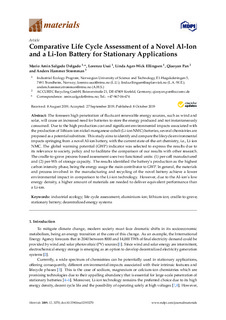| dc.contributor.author | Delgado, Mario Amin Salgado | |
| dc.contributor.author | Usai, Lorenzo | |
| dc.contributor.author | Pan, Qiaoyan | |
| dc.contributor.author | Strømman, Anders Hammer | |
| dc.date.accessioned | 2020-02-18T07:30:03Z | |
| dc.date.available | 2020-02-18T07:30:03Z | |
| dc.date.created | 2019-11-21T17:36:35Z | |
| dc.date.issued | 2019 | |
| dc.identifier.citation | Materials. 2019, 12 (19), 1-14. | nb_NO |
| dc.identifier.issn | 1996-1944 | |
| dc.identifier.uri | http://hdl.handle.net/11250/2642112 | |
| dc.description.abstract | The foreseen high penetration of fluctuant renewable energy sources, such as wind andsolar, will cause an increased need for batteries to store the energy produced and not instantaneouslyconsumed. Due to the high production cost and significant environmental impacts associated withthe production of lithium-ion nickel-manganese-cobalt (Li-ion NMC) batteries, several chemistries areproposed as a potential substitute. This study aims to identify and compare the lifecycle environmentalimpacts springing from a novel Al-ion battery, with the current state-of-the-art chemistry, i.e., Li-ionNMC. The global warming potential (GWP) indicator was selected to express the results due toits relevance to society, policy and to facilitate the comparison of our results with other research.The cradle-to-grave process-based assessment uses two functional units: (1) per-cell manufacturedand (2) per-Wh of storage capacity. The results identified the battery’s production as the highestcarbon intensity phase, being the energy usage the main contributor to GWP. In general, the materialsand process involved in the manufacturing and recycling of the novel battery achieve a lowerenvironmental impact in comparison to the Li-ion technology. However, due to the Al-ion’s lowenergy density, a higher amount of materials are needed to deliver equivalent performance thana Li-ion. | nb_NO |
| dc.language.iso | eng | nb_NO |
| dc.publisher | MDPI | nb_NO |
| dc.rights | Navngivelse 4.0 Internasjonal | * |
| dc.rights.uri | http://creativecommons.org/licenses/by/4.0/deed.no | * |
| dc.title | Comparative Life Cycle Assessment of a Novel Al-Ion and a Li-Ion Battery for Stationary Applications | nb_NO |
| dc.type | Journal article | nb_NO |
| dc.type | Peer reviewed | nb_NO |
| dc.description.version | publishedVersion | nb_NO |
| dc.source.pagenumber | 1-14 | nb_NO |
| dc.source.volume | 12 | nb_NO |
| dc.source.journal | Materials | nb_NO |
| dc.source.issue | 19 | nb_NO |
| dc.identifier.doi | 10.3390/ma12193270 | |
| dc.identifier.cristin | 1750705 | |
| dc.description.localcode | ©2019 by the authors. Licensee MDPI, Basel, Switzerland. This article is an open accessarticle distributed under the terms and conditions of the Creative Commons Attribution(CC BY) license (http://creativecommons.org/licenses/by/4.0/) | nb_NO |
| cristin.unitcode | 194,64,25,0 | |
| cristin.unitname | Institutt for energi- og prosessteknikk | |
| cristin.ispublished | true | |
| cristin.fulltext | original | |
| cristin.qualitycode | 1 | |

